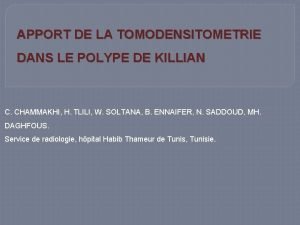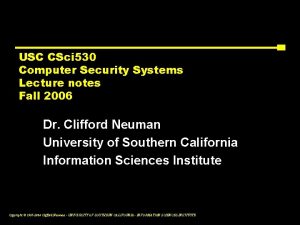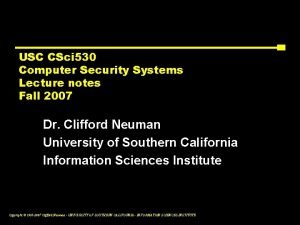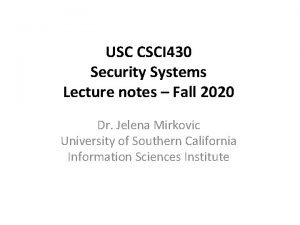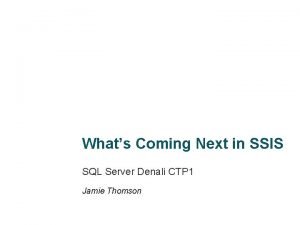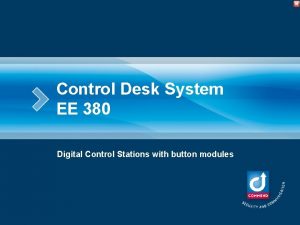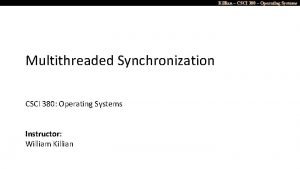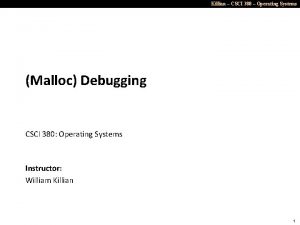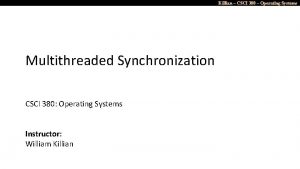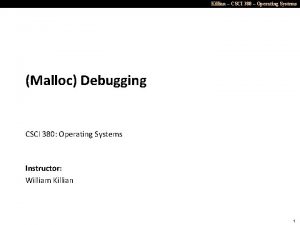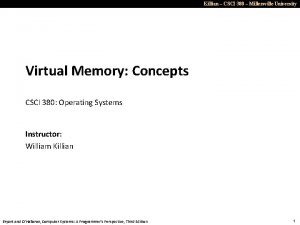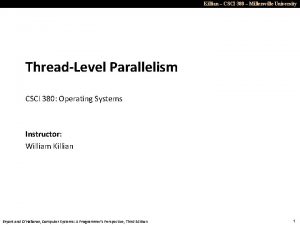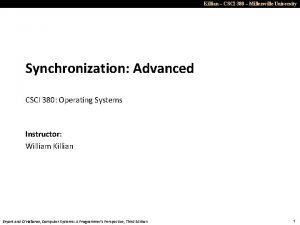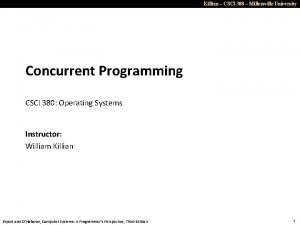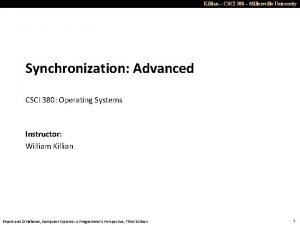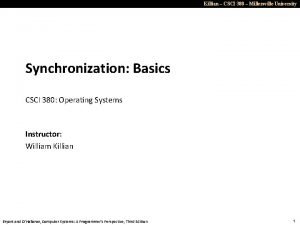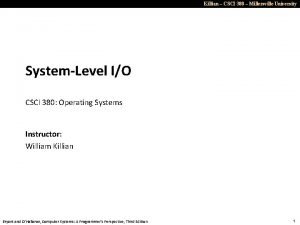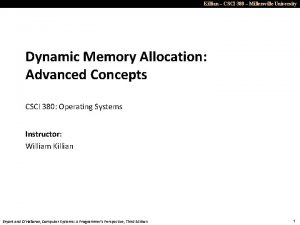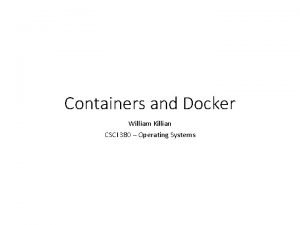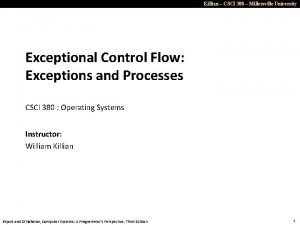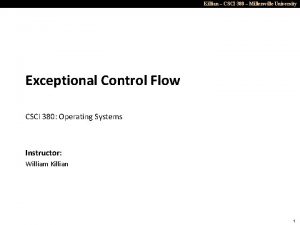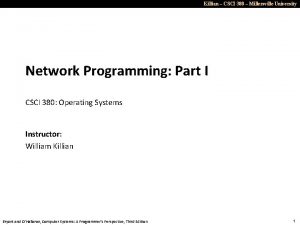Killian CSCI 380 Operating Systems Virtual Memory CSCI






















- Slides: 22

Killian – CSCI 380 – Operating Systems Virtual Memory CSCI 380: Operating Systems William Killian 1

Killian – CSCI 380 – Operating Systems I/O Basics ¢ Four basic operations: § § ¢ open close read write What’s a file descriptor? § Returned by open. § int fd = open(“/path/to/file”, O_RDONLY); § fd is some positive value or -1 to denote error ¢ Every process starts with 3 open file descriptors that can be accessed macros like STDOUT_FILENO § 0 - STDIN § 1 - STDOUT § 2 - STDERR 2

Killian – CSCI 380 – Operating Systems How the Unix Kernel Represents Open Files ¢ Two descriptors referencing two distinct open files. Descriptor 1 (stdout) points to terminal, and descriptor 4 points to open disk file Descriptor table [one table per process] Open file table [shared by all processes] v-node table [shared by all processes] File A (terminal) File pos refcnt=1 File B (disk) File pos Info in stat struct File access File size File type . . . refcnt=1 File access File size File type. . . stdin fd 0 stdout fd 1 stderr fd 2 fd 3 fd 4 3

Killian – CSCI 380 – Operating Systems File Sharing ¢ Two distinct descriptors sharing the same disk file through two distinct open file table entries § E. g. , Calling open twice with the same filename argument Descriptor table [one table per process] Open file table [shared by all processes] v-node table [shared by all processes] File A (disk) refcnt=1 File access File size File type . . . stdin fd 0 stdout fd 1 stderr fd 2 fd 3 fd 4 File pos File B (disk) File pos refcnt=1 . . . 4

Killian – CSCI 380 – Operating Systems How Processes Share Files: fork ¢ A child process inherits parent’s open files § Note: situation unchanged by exec functions (use fcntl to change) ¢ Before fork call: Descriptor table [one table per process] Open file table [shared by all processes] v-node table [shared by all processes] File A (terminal) File pos refcnt=1 File B (disk) File pos File access File size File type . . . refcnt=1 File access File size File type. . . stdin fd 0 stdout fd 1 stderr fd 2 fd 3 fd 4 5

Killian – CSCI 380 – Operating Systems How Processes Share Files: fork ¢ ¢ A child process inherits parent’s open files After fork: § Child’s table same as parent’s, and +1 to each refcnt Descriptor table [one table per process] Parent refcnt=2 . . . File B (disk) File pos File access File size File type. . . refcnt=2 . . . fd 0 fd 1 fd 2 fd 3 fd 4 File A (terminal) File pos Child v-node table [shared by all processes] . . . fd 0 fd 1 fd 2 fd 3 fd 4 Open file table [shared by all processes] 6

Killian – CSCI 380 – Operating Systems I/O Redirection ¢ Question: How does a shell implement I/O redirection? linux> ls > foo. txt ¢ Answer: By calling the dup 2(oldfd, newfd) function § Copies (per-process) descriptor table entry oldfd to entry newfd Descriptor table before dup 2(4, 1) fd 0 fd 1 fd 2 fd 3 fd 4 a b Descriptor table after dup 2(4, 1) fd 0 fd 1 fd 2 fd 3 fd 4 b b 7

Killian – CSCI 380 – Operating Systems I/O Redirection Example ¢ Step #1: open file to which stdout should be redirected § Happens in child executing shell code, before exec Descriptor table [one table per process] Open file table [shared by all processes] v-node table [shared by all processes] File A File pos refcnt=1 File B File pos File access File size File type . . . refcnt=1 File access File size File type. . . stdin fd 0 stdout fd 1 stderr fd 2 fd 3 fd 4 8

Killian – CSCI 380 – Operating Systems I/O Redirection Example (cont. ) ¢ Step #2: call dup 2(4, 1) § cause fd=1 (stdout) to refer to disk file pointed at by fd=4 Descriptor table [one table per process] Open file table [shared by all processes] v-node table [shared by all processes] File A File pos refcnt=0 File B File pos File access File size File type . . . refcnt=2 File access File size File type. . . stdin fd 0 stdout fd 1 stderr fd 2 fd 3 fd 4 9

Killian – CSCI 380 – Operating Systems Malloc Lab Sneak Preview ¢ ¢ You will write your own dynamic storage allocator – i. e. , your own malloc, free, realloc, calloc. This week in class, you will learn about different ways to keep track of free and allocated blocks of memory. § Implicit linked list of blocks. § Explicit linked list of free blocks. § Segregated lists of different size free blocks. ¢ Other design decisions: § How will you look for free blocks? (First fit, next fit, best fit…) § Should the linked lists be doubly linked? § When do you coalesce blocks? ¢ This is exactly what you’ll do in this lab, so pay lots of attention in class. 10

Killian – CSCI 380 – Operating Systems Malloc Lab Sneak Preview ¢ ¢ If you haven’t been using version control so far, this is a good time to start. Workflow: § § ¢ Implement indirect linked lists. Make sure it works. Implement explicit linked lists. Make sure it still works. Implement segregated lists. Make sure it still works. You WILL break things and need to revert. Barebones guide to using git: § git init starts a local repository. § git add foo. c adds foo. c to that repository. § git commit -a –m ‘Describe changes here’ updates your repository with the current state of all files you’ve added. 11

Killian – CSCI 380 – Operating Systems Agenda ¢ ¢ Shell Lab FAQs Malloc Lab Sneak Preview Virtual Memory Concepts Address Translation 12

Killian – CSCI 380 – Operating Systems Virtual Memory Concepts ¢ ¢ We’ve been viewing memory as a linear array. But wait! If you’re running 5 processes with stacks at 0 x. C 0000000, don’t their addresses conflict? 0 x. C 0000000 0 x 40000000 0 x 08048000 %esp (stack pointer) Memory-mapped region for shared libraries Run-time heap (created by malloc) Nope! Each process has its own address space. How? ? ? Kernel virtual memory User stack (created at runtime) Memory invisible to user code Read/write segment (. data, . bss) Read-only segment (. init, . text, . rodata) brk Loaded from the executable file Unused 13

Killian – CSCI 380 – Operating Systems Virtual memory concepts ¢ We define a mapping from the virtual address used by the process to the actual physical address of the data in memory. Image: http: //en. wikipedia. org/wiki/File: Virtual_address_space_and_physi cal_address_space_relationship. sv g 14

Killian – CSCI 380 – Operating Systems Virtual memory concepts This explains why two different processes can use the same address. It also lets them share data and protects their data from illegal accesses. Hooray for virtual memory! Virtual Address Space for Process 1: 0 VP 1 VP 2 Address translation 0 PP 2 . . . Physical Address Space (DRAM) N-1 PP 6 Virtual Address Space for Process 2: 0 PP 8 VP 1 VP 2 . . . N-1 (e. g. , read-only library code) M-1 15

Killian – CSCI 380 – Operating Systems Virtual memory concepts ¢ Page table § Lets us look up the physical address corresponding to any virtual address. (Array of physical addresses, indexed by virtual address. ) ¢ TLB (Translation Lookaside Buffer) § A special tiny cache just for page table entries. § Speeds up translation. ¢ Multi-level page tables § The address space is often sparse. § Use page directory to map large chunks of memory to a page table. § Mark large unmapped regions as non-present in page directory instead of storing page tables full of invalid entries. 16

Killian – CSCI 380 – Operating Systems Agenda ¢ ¢ Shell Lab FAQs Malloc Lab Sneak Preview Virtual Memory Concepts Address Translation 17

Killian – CSCI 380 – Operating Systems VM Address Translation ¢ Virtual Address Space § V = {0, 1, …, N– 1} § There are N possible virtual addresses. § Virtual addresses are n bits long; 2 n = N. ¢ Physical Address Space § P = {0, 1, …, M– 1} § There are M possible physical addresses. § Virtual addresses are m bits long; 2 m = M. ¢ Memory is grouped into “pages. ” § Page size is P bytes. § The address offset is p bytes; 2 p = P. § Since the virtual offset (VPO) and physical offset (PPO) are the same, the offset doesn’t need to be translated. 18

Killian – CSCI 380 – Operating Systems VM Address Translation Virtual address n-1 Page table base register (PTBR) Page table address for process Virtual page number (VPN) p p-1 0 Virtual page offset (VPO) Page table Valid Physical page number (PPN) Valid bit = 0: page not in memory (page fault) m-1 Physical page number (PPN) p p-1 0 Physical page offset (PPO) Physical address 19

Killian – CSCI 380 – Operating Systems VM Address Translation ¢ Addressing § 14 -bit virtual addresses § 12 -bit physical address § Page size = 64 bytes 13 12 11 10 9 8 7 6 5 4 3 2 1 VPN VPO Virtual Page Number Virtual Page Offset 11 10 9 8 7 6 5 4 3 2 1 PPN PPO Physical Page Number Physical Page Offset 0 0 20

Killian – CSCI 380 – Operating Systems Example: Address Translation ¢ ¢ Pages are 64 bytes. How many bits is the offset? Find 0 x 03 D 4. 13 12 11 10 9 8 7 6 5 ¢ ¢ 3 2 1 0 VPO VPN ¢ 4 VPN 00 01 02 03 04 05 06 07 VPN: _____ PPN: ______ Physical address: ______ PPN 28 – 33 02 – 16 – – Valid 1 0 1 0 0 VPN 08 09 0 A 0 B 0 C 0 D 0 E 0 F PPO PPN 13 17 09 – – 2 D 11 0 D Valid 1 1 1 0 0 1 1 1 21

Killian – CSCI 380 – Operating Systems Example: Address Translation ¢ ¢ Pages are 64 bytes. How many bits is the offset? log 2 64 = 6 Find 0 x 03 D 4. 13 12 11 10 9 8 7 6 5 4 3 2 1 0 0 0 1 1 0 1 0 0 VPO VPN ¢ ¢ ¢ VPN 00 01 02 03 04 05 06 07 0 x 0 F VPN: _____ 0 x 0 D PPN: ______ Physical address: 0 x 0354 ______ 0 0 1 PPN 28 – 33 02 – 16 – – 0 Valid 1 0 1 0 VPN 08 09 0 A 0 B 0 C 0 D 0 E 0 F 1 0 PPO PPN 13 17 09 – – 2 D 11 0 D 1 0 Valid 1 1 1 0 0 1 1 1 0 22
 Virtual memory in os
Virtual memory in os Virtual memory in os
Virtual memory in os Page fault
Page fault Virtual memory in memory hierarchy consists of
Virtual memory in memory hierarchy consists of Killian üçgeni
Killian üçgeni Clasificación kodsi candida
Clasificación kodsi candida Butch killian
Butch killian Polype de killian histologie
Polype de killian histologie Trigonum laimeri
Trigonum laimeri Miami killian senior high school rating
Miami killian senior high school rating Trigonum laimeri
Trigonum laimeri Csci 530 security systems
Csci 530 security systems Csci 530 security systems
Csci 530 security systems Csci 530 security systems
Csci 530 security systems Ssis-380
Ssis-380 Ee 380
Ee 380 690-380
690-380 804 en yakın onluğa yuvarlama
804 en yakın onluğa yuvarlama Zodiac cadet fastroller
Zodiac cadet fastroller 380 gelir tahakkukları
380 gelir tahakkukları Ponbua
Ponbua Rheolube 363
Rheolube 363 Dönem ayırıcı hesaplar
Dönem ayırıcı hesaplar







